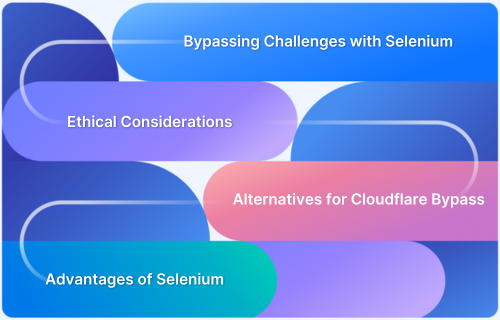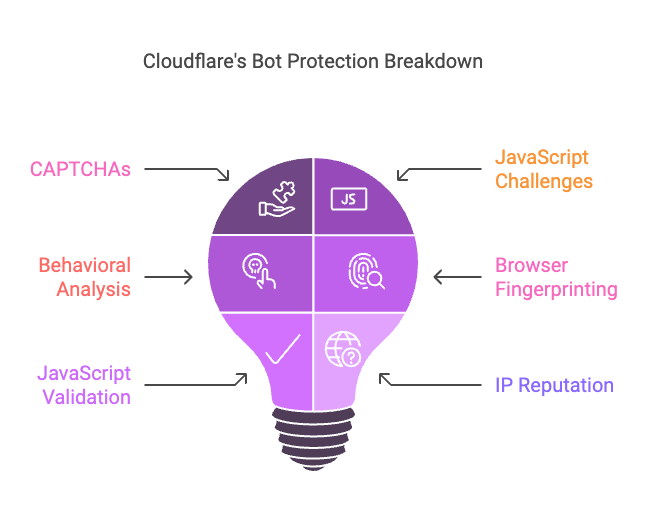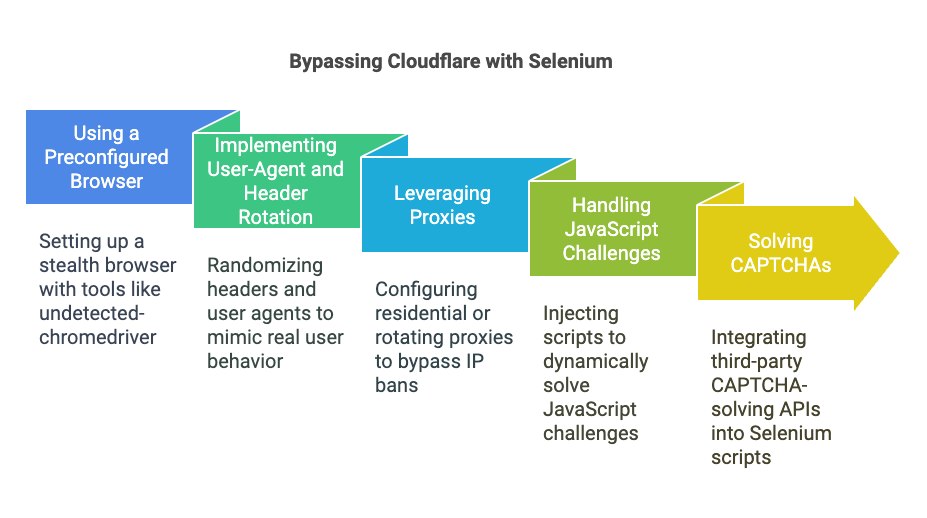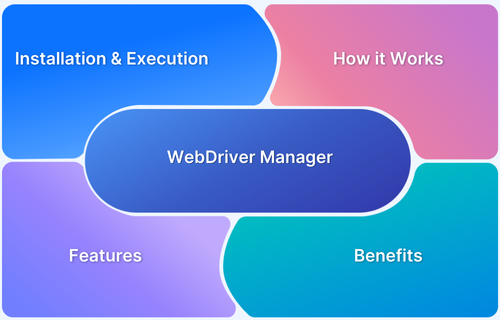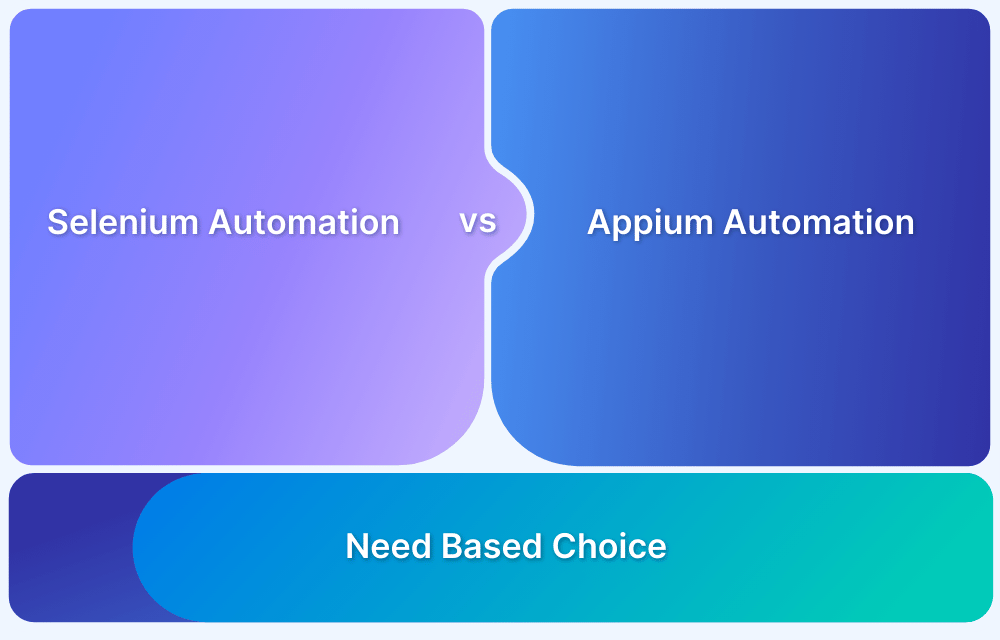Cloudflare has become a key player in protecting websites from malicious traffic and DDoS attacks. However, these protective layers can be a significant hurdle for automation engineers and web scrapers using tools like Selenium.
Overview
What is Cloudflare?
Cloudflare is a security and performance platform that protects websites from DDoS attacks, bots, and malicious traffic while optimizing web delivery.
Challenges with Cloudflare for Web Engineers & Scrapers:
Cloudflare’s security measures CAPTCHAs, bot detection, IP blacklisting, and rate limits – block automation, making web scraping and testing difficult.
Tools and Techniques to Bypass Cloudflare with Selenium
- Using a Preconfigured Browser
- Implementing User-Agent and Header Rotation
- Leveraging Proxies
- Handling JavaScript Challenges
- Solving CAPTCHAs
This guide delves into strategies for bypassing these challenges using Selenium while adhering to ethical and legal standards.
Whether you’re a test automation engineer or a data enthusiast, this article will equip you with actionable techniques and code examples to tackle Cloudflare’s advanced bot protection.
Understanding Cloudflare Challenges
Cloudflare challenges work by detecting and filtering out bots. Let’s break down the types of challenges and how they detect automated tools like Selenium.
What are Cloudflare Challenges?
Cloudflare uses a variety of techniques to identify and block automated traffic:
- CAPTCHAs: Requiring users to solve puzzles or select images.
- JavaScript Challenges: Checking the browser’s ability to execute scripts, which bots often lack.
- Behavioral Analysis: Monitoring browsing patterns, such as mouse movements and keystrokes, to identify bots.
How Cloudflare Detects Bots
Cloudflare employs several advanced methods to differentiate between human users and automated scripts:
- Browser Fingerprinting: Examining headers, user-agent strings, and browser configurations.
- JavaScript Validation: Executing dynamic scripts to detect anomalies in browser behavior.
- IP Reputation: Blocking suspicious or flagged IPs based on their history.
- Behavioral Analysis: Tracking interactions like mouse movement, scroll events, and key presses.
Common Scenarios Where Cloudflare Blocks Selenium
There are several ways Selenium can trigger Cloudflare’s bot protection:
- Running a headless browser, which lacks human interaction signals.
- Using a static IP address that’s been flagged as suspicious.
- Missing browser headers or providing unrealistic configurations.
- Sending frequent requests in a short span mimicking bot-like behavior.
Tools and Techniques to Bypass Cloudflare with Selenium
Successfully bypassing Cloudflare’s security requires a combination of strategies that make your Selenium script appear like a real browser operated by a human. Below are the most effective tools and techniques to achieve this.
1. Using a Preconfigured Browser
Cloudflare often flags headless browsers. Tools like undetected-chromedriver and selenium-stealth can help make browsers appear more “human” by employing methods like header modification, etc.
Undetected Chromedriver:
Install the undetected-chromedriver library:
bash
pip install undetected-chromedriver
Integrate it with Selenium:
python
import undetected_chromedriver as uc driver = uc.Chrome(headless=True,use_subprocess=False) driver.get('https://nowsecure.nl')
Selenium Stealth:
Install the Selenium Stealth Library:
bash
pip install selenium-stealth
Create And run a simple selenium script to open a site with anti-bot detection
Python
from selenium import webdriver from selenium_stealth import stealth # create ChromeOptions object options = webdriver.ChromeOptions() options.add_argument('--headless') # Set up WebDriver driver = webdriver.Chrome(options=options) # Open a webpage driver.get("https://opensea.io/") print(driver.title) driver.quit()
2. Implementing User-Agent and Header Rotation
Cloudflare relies heavily on analyzing browser headers and user-agent strings. Static headers or missing data are clear signs of bot activity. Rotating user-agent strings and randomizing headers can make your script appear more legitimate.
Importance of Rotating Headers
- Ensures variability in requests, mimicking different devices or users.
- Helps avoid IP blacklisting.
Code Example for Header and User-Agent Rotation:
python
from selenium import webdriver from selenium_stealth import stealth from fake_useragent import UserAgent # Generate a random User-Agent user_agent = UserAgent().random # create ChromeOptions object options = webdriver.ChromeOptions() options.add_argument('--headless') options.add_argument(f"user-agent={user_agent}") # Set up WebDriver driver = webdriver.Chrome(options=options) # Open a webpage driver.get("https://www.whatismybrowser.com/") print(f"Using User-Agent: {user_agent}") driver.quit()
To further enhance this, you can pair it with rotating proxies.
3. Leveraging Proxies
Cloudflare frequently blocks IPs associated with bots. Using residential or rotating proxies can help distribute requests across multiple IP addresses.
Best Practices for Using Proxies:
- Choose High-Quality Proxies: Residential proxies are harder to detect.
- Rotate Proxies: Avoid sending all requests from the same IP.
- Avoid Free Proxies: These are often flagged as suspicious.
Configuring Proxies in Selenium:
python
from selenium import webdriver proxy = 'RESIDENTIAL_PROXY_IP:PORT' options = webdriver.ChromeOptions() options.add_argument(f'--proxy-server={proxy}') driver = webdriver.Chrome(options=options) driver.get('https://www.bstackdemo.com/')
Read More: How to set Proxy in Selenium?
4. Handling JavaScript Challenges
JavaScript challenges execute dynamic scripts to detect automation tools. Selenium allows you to inject custom JavaScript to handle these challenges.
Example: Mimicking JavaScript Execution
python
# Disable WebDriver flag driver.execute_script("Object.defineProperty(navigator, 'webdriver', {get: () => undefined})") # Execute Cloudflare's challenge script driver.execute_script("return navigator.language")
This simulates browser-like behavior, reducing the chances of detection.
5. Solving CAPTCHAs
CAPTCHAs are a significant hurdle, but third-party services like 2Captcha and Anti-Captcha can solve them programmatically.
How CAPTCHA Solvers Work
- Submit the CAPTCHA challenge to the API.
- Wait for the API to return the solution.
- Inject the solution into the webpage.
Example Code for CAPTCHA Solving:
python
import requests api_key = 'YOUR_2CAPTCHA_API_KEY' site_key = 'CAPTCHA_SITE_KEY' url = 'https://example.com' # Submit CAPTCHA request response = requests.post( 'http://2captcha.com/in.php', data={ 'key': api_key, 'method': 'userrecaptcha', 'googlekey': site_key, 'pageurl': url } ) captcha_id = response.text.split('|')[1] # Retrieve solution captcha_solution = requests.get( f'http://2captcha.com/res.php?key={api_key}&action=get&id={captcha_id}' ).text.split('|')[1] # Inject CAPTCHA solution into the webpage driver.execute_script(f'document.getElementById('g-recaptcha-response').value='{captcha_solution}'")
Read More: How to handle Captcha in Selenium
Ethical Considerations in Bypassing Cloudflare Challenges
Bypassing Cloudflare challenges comes with significant ethical and legal implications. While the technical aspects of this process are fascinating, it’s essential to approach it responsibly to avoid misuse or legal repercussions.
Here are key considerations:
1. Adhere to Website Terms of Service: Most websites have terms of service (ToS) that outline acceptable use. Violating these terms can lead to legal consequences or being permanently banned from accessing the website.
Always review a site’s ToS before engaging in automated actions.
2. Avoid Aggressive Scraping: Flooding a website with requests can overload its servers, leading to downtime for legitimate users. Implement rate-limiting techniques and pause between requests to mimic normal user behavior.
3. Protect Privacy: Never scrape or automate actions involving sensitive user data, private information, or copyrighted material.
Handling this information improperly can lead to legal penalties and harm the trustworthiness of your work.
4. Use Data Responsibly: If you’re extracting data for analysis, ensure it complies with data protection regulations like GDPR or CCPA.
Never use automation for malicious purposes, such as credential stuffing or spamming.
5. Communicate Your Intentions: If possible, reach out to the website owner or administrator to request permission for automation.
In some cases, they may provide access via an API or other means that reduce the need to bypass protections.
Common Pitfalls and Troubleshooting
Even with a well-structured approach, bypassing Cloudflare challenges can result in unexpected errors or roadblocks. Understanding common issues and how to troubleshoot them is vital for smooth automation.
Common Issues in Bypassing Cloudflare Challenges:
- Browser Detection Issues
- Frequent CAPTCHAs
- Timeout Errors
- Proxy Misconfiguration
- IP Blacklisting
- JavaScript Challenge Failures
1. Browser Detection Issues
Problem: Cloudflare detects and blocks headless browsers, even with stealth plugins.
Solution:
- Ensure that undetected-chromedriver or other stealth tools are updated.
- Modify browser properties (for example, disable navigator.webdriver detection).
2. Frequent CAPTCHAs
Problem: Your script frequently encounters CAPTCHAs.
Solution:
- Integrate third-party CAPTCHA solvers like 2Captcha.
- Use residential proxies to prevent IP-based CAPTCHAs.
3. Timeout Errors
Problem: Cloudflare challenges may delay responses, causing Selenium scripts to timeout.
Solution:
- Increase timeouts in Selenium WebDriver configuration.
- Implement retry logic for requests.
4. Proxy Misconfiguration
Problem: Incorrectly configured proxies fail to route traffic.
Solution:
- Test proxy configurations with simple HTTP requests before integrating them with Selenium.
- Use reliable proxy providers to avoid flagged IPs.
5. IP Blacklisting
Problem: Your IP is flagged due to excessive requests.
Solution:
- Rotate proxies frequently.
- Avoid sending too many requests in a short span.
6. JavaScript Challenge Failures
Problem: Scripts fail to execute JavaScript challenges dynamically.
Solution:
- Use Selenium’s execute_script method to handle JavaScript directly.
- Monitor responses to ensure the challenge was solved correctly.
Read More: What is IP Whitelisting
Alternatives to Selenium for Cloudflare Bypass
While Selenium is versatile, it may not always be the best tool for bypassing Cloudflare’s complex protections.
Here are some alternatives and their advantages:
1. Puppeteer
Puppeteer is a Node.js library for controlling headless Chrome browsers. It has robust stealth plugins that reduce bot detection.
Advantages:
- Built-in support for handling JavaScript-heavy websites.
- Stealth mode plugins like puppeteer-extra-plugin-stealth.
2. Playwright
Playwright, developed by Microsoft, is a powerful automation tool for handling multi-browser environments.
Advantages:
- Provides better support for handling complex challenges like CAPTCHAs and JavaScript tests.
- Easier debugging with detailed trace and video recordings.
3. Scrapy with Middleware
Scrapy is a Python-based scraping framework that integrates well with middleware for managing requests and proxies.
Advantages:
- Efficient for large-scale scraping tasks.
- Can be combined with JavaScript rendering tools like Splash.
4. BrowserStack Automate
BrowserStack Automate’s cloud-based platform offers pre-configured environments to execute Selenium tests seamlessly without worrying about local setups.
Advantages:
- Scalable and reliable infrastructure.
- No need for managing stealth setups locally.
Advantages of Selenium for Cloudflare Challenges
Despite its challenges, Selenium remains a preferred tool for bypassing Cloudflare due to its flexibility and wide community support.
1. Customization
Selenium allows deep customization of browser behavior through options, scripts, and extensions, making it adaptable for various scenarios.
2. Integration Capabilities
Works seamlessly with tools like:
- fake_useragent for randomizing headers.
- Proxy management libraries for handling IP rotation.
- CAPTCHA solvers for automating challenges.
3. Browser Versatility
Selenium supports all major browsers, including Chrome, Firefox, Safari, and Edge, enabling cross browser testing and scraping.
4. Community and Documentation
- Selenium’s large community ensures quick access to solutions for common issues.
- Comprehensive documentation makes it beginner-friendly while offering advanced techniques for experienced users.
Why choose BrowserStack to run Selenium Tests?
BrowserStack Automate is a cloud-based platform that simplifies running Selenium tests across multiple environments. Here’s why it stands out:
- Preconfigured Environments: No need to set up local environments. Test on a range of browser and OS combinations out of the box.
- Scalability: Run hundreds of parallel tests to accelerate execution. Ideal for large-scale automation projects.
- Real Device Testing: Access real mobile devices and browsers, ensuring your automation is tested under real-world conditions.
- Geolocation Testing: Simulate traffic from different countries to analyze how Cloudflare challenges vary by region.
- Enhanced Debugging: BrowserStack provides features like screenshots, video recordings, and console logs to debug Selenium tests efficiently.
- Cost-Effective: Eliminates the need to maintain a complex local infrastructure, saving time and resources.
Conclusion
Bypassing Cloudflare challenges using Selenium involves combining advanced elements like stealth browsers, proxies, CAPTCHA solvers, and human-like behavior. While these methods are technically impressive, always prioritize ethical practices and adhere to legal boundaries.
For a more robust and scalable solution, platforms like BrowserStack Automate offer a streamlined way to execute Selenium tests across real browsers and devices. With the right tools and techniques, automation engineers can overcome Cloudflare’s challenges while maintaining compliance and efficiency.
tools and techniques, automation engineers can overcome Cloudflare’s challenges while maintaining compliance and efficiency.
